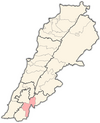Hula, Lebanon
Hula
حولا | |
|---|---|
Village | |
 Hula Location within Lebanon | |
| Coordinates: 33°12′36″N 35°31′01″E / 33.21000°N 35.51694°ECoordinates: 33°12′36″N 35°31′01″E / 33.21000°N 35.51694°E | |
| Grid position | 198/290 PAL |
| Country | |
| Governorate | Nabatieh Governorate |
| District | Marjeyoun District |
| Elevation | 750 m (2,460 ft) |
| Time zone | UTC+2 (EET) |
| • Summer (DST) | UTC+3 (EEST) |
| Dialing code | +961 |
| Website | http://houla.net |
Hula (Houla, Arabic: حولا)[1] is a small village in southern Lebanon, on the southern side of the Litani river near the border with Israel. A common family name there is the family of Ktaish (قطيش). It is located 900 meters above sea-level.

The village maintains its cultural traditions to the present day, and holds village festivals.


During the 1948 Arab-Israeli war two officers from the IDF carried out the Hula massacre in the village, killing over 80 civilians of ages 15–60.[2]
History[]
The Survey of Western Palestine (1881) mentions several ancient lintels and one olive-press having been found at Hula.[3]
Ottoman period[]
In 1875 Victor Guérin explores the geographical location of Houla and other Southern villages of Lebanon bordering Palestine, and found that Hula had 300 Muslim inhabitants.[4]
In 1881, the PEF's Survey of Western Palestine (SWP) described it as: "A village, built of stone, containing about 500 Muslims, one of the most prominent objects in which is a Sheikh's tomb. It is situated on the hill-top, and is surrounded by olives, vines, and arable land. There are several cisterns, two birkets (one rock-cut), and a spring."[5] It also mentions that a small central mosque is situated on top of one of the hills in the village.[3]
Modern era[]
In October 24, 1948, the city fell in Israeli's occupation without resistance, children and women were expelled, and men aging from 15 to 60 were gathered in a house. Between October 30, and November 1 these men were shot dead by and his friend, and then they blow the house on their dead bodies. an incident which is known as the Hula massacre. During the 2006 Israel-Lebanon conflict, on July 15, Israel killed 2 young women in an air-strike against a home in Hula.[6] On August 7, 2006, an Israeli airstrike on Houla killed another civilian.[7][8]
Notable people[]
- Abdel-Karim Yassine (عبد الكريم ياسين): A successful businessman who was among the first Lebanese to start a clothing trading business in Kuwait.[9][circular reference]
- Sheikh Mohammed bin Sulaiman Jawad bin Sheikh Hassan Al-Sulaiman (شمس الدين محمد بن محمد بن الحسن الحولاني): Writer and poet
- Jaafar bin Hassan bin Ayoub bin Najm Al-Din Al-Araji Al-Atrawi (السيد جعفر بن حسن بن أيوب بن نجم الدين الاعرجي الاطراوي)
- Sheikh Najm al-Din bin Abd al-Imam bin Sheikh Shams al-Din[10][11] (الشيخ نجم الدين بن عبد الإمام بن الشيخ شمس الدين)
- Ibn Najm al-Din al-Atarawi (السيد ابن نجم الدين أيوب الاطراوي العاملي), a scholar of the eighth century AH, and one of the students of the martyr, Muhammad bin Jamal al-Din Makki.
- Shams al-Din Muhammad bin Muhammad bin al-Hasan al-Houlani (شمس الدين محمد بن محمد بن الحسن الحولاني), a scholar and investigator who became famous in his era (825 AH/1445 CE)

References[]
- ^ Meaning: "properly dark green herbage", according to Palmer, 1881, p. 21
- ^ Journal of Palestine Studies, vol. VII, no. 4 (summer 1978), no. 28, pp. 143-145
- ^ Jump up to: a b Conder and Kitchener, 1881, SWP I, p. 116
- ^ Guerin, 1880, pp. 382-383
- ^ Conder and Kitchener, 1881, SWP I, p. 87
- ^ HRW, 2007, p. 91
- ^ HRW, 2007, p. 136
- ^ Booth, Jenny; agencies (August 7, 2006). "Israel threatens to widen offensive in Lebanon". The Times.
- ^ "تاريخ الكويت". www.kuwait-history.net (in Arabic). Retrieved 2017-12-28.
- ^ اخبار (2016). "حولا".
- ^ "حولا", ويكيبيديا، الموسوعة الحرة (in Arabic), 2018-10-27, retrieved 2018-11-08
Bibliography[]
- Conder, C.R.; Kitchener, H.H. (1881). The Survey of Western Palestine: Memoirs of the Topography, Orography, Hydrography, and Archaeology. 1. London: Committee of the Palestine Exploration Fund.
- Guérin, V. (1880). Description Géographique Historique et Archéologique de la Palestine (in French). 3: Galilee, pt. 2. Paris: L'Imprimerie Nationale.
- HRW (2007). Why They Died: Civilian Casualties in Lebanon During the 2006 War. Human Rights Watch.
- Palmer, E.H. (1881). The Survey of Western Palestine: Arabic and English Name Lists Collected During the Survey by Lieutenants Conder and Kitchener, R. E. Transliterated and Explained by E.H. Palmer. Committee of the Palestine Exploration Fund.

External links[]
- Survey of Western Palestine, Map 2: IAA, Wikimedia commons
- Houla, Localiban
- Populated places in Marjeyoun District
- Populated places in Lebanon
- Shia Muslim communities in Lebanon

